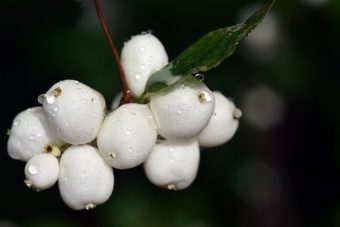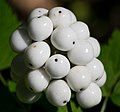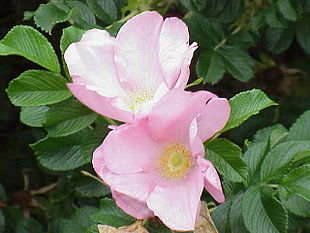In this article, we will be discussing the best ornamental fruit plants to have in your container garden.
In autumn, many colours are plenty, where leaves of many shades are to be found but colourful leaves are not the only thing to be found. You will find some flowers in autumn, but your choice is limited. Your best choice is to go for ornamental varieties, which still add texture and colour and interest to your container design at a dull time of year for the garden.

They will also supply our wildlife friends with a valuable source of food.
You can decorate your garden with plenty of ornamental and edible fruits, such as apple and pear trees (See my article on fruit trees in containers to get a better selection of what can be grown) for both taste and colour. The fruit of roses and cotoneasters introduce vibrant red and will combine well with berries in other shades; the violet berries of the beautyberry, the white berries of Gaultheria.
The unfortunate thing for container gardens is that the many fruits tend to be borne on large trees and shrubs and therefore cannot be grown in the container garden.
The ones highlighted in this article will be suitable for container gardeners. They have a big spread and so you will need wide spaces to be able to enjoy them fully.
The following plants noted for their ornamental fruits are recommended to be grown in containers.
ACTAEA PACHYPODA (White Baneberry)

This clump-forming, 1m tall perennial has bright green, divided leaves, where in midsummer, it produces upright spikes of fluffy, white flowers. This is followed by oval, black tippled., very attractive white berries on top of stiff, bright stalks in autumn.
Grow this beauty in a large container full of moisture-retentive, multipurpose compost in the partial shade.
ARONIA X PRUNIFOLIA (Purple Chokeberry)

This is a 3m tall, upright shrub that has dark green, oval leaves and in spring, white flowers appear. This American native then produces purple-black berries that make a stunning contrast to its fiery red autumn leaves.
Grow this shrub in a very large container full of well-drained, multipurpose compost in partial shade.
BILLARDIERA LONGIFLORA (Climbing Blueberry)

This 2m tall, evergreen, twining climber has green, narrow leaves and small, insignificant, greenish-yellow, bell-shaped flowers. In autumn, purple-blue fruits with a metallic appearance develop. Prefers to be grown in a large container full of well-drained, multipurpose compost in a warm sheltered site, preferably against a wall.
CALLICARPA BODINIERI VAR. GIRALDII (Beauty Berry)

This is a 3m tall, bushy, deciduous shrub that has oval, purple-tinted leaves, from which tiny, lilac flowers appear, In autumn, these flowers produce dense clusters of small, violet, spherical berries, set at regular intervals. Grow it in a large container full of multipurpose compost in full sun or partial shade. It is not a fussy plant and will tolerate dry and moisture- retentive compost.
A more compact variety is C. dichotoma, which is rounded and shorter, only growing up to 1.2m in height. The flowers are the familiar iliac colour, but the berries are violet and smaller. The green leaves turn yellow in autumn.
COTONEASTER HORIZONTALIS

This 1m tall shrub has attractive stems that follow a ‘herringbone’ pattern. The small, glossy oval leaves are dotted in autumn and in early winter spherical red berries are produced that are often eaten by birds. It is best trained against a wall in a container full of well-drained, multipurpose compost in full sun or partial shade.
GAULTHERIA MUCRONATA

This small, 1.2m tall, evergreen shrub has small, prickly, green leaves and in spring, tiny, white flowers appear. This is not the main attraction of the plant and the large spherical berries are the main show that comes in shades of white, pink, or crimson. To do this, a female variety needs a male partner plant to be close by. Grow it in a large container full of well-drained, ericaceous compost in partial shade.
IRIS FOETIDISSIMA (Stinking Iris)

This evergreen, 90cm tall perennial has green, sword-shaped leaves and yellow and purple-tinged blooms from early to midsummer. In autumn, the seed pods split revealing the beauty of the orange-red berries. Grow this drought-tolerant perennial in a container full of well-drained, multipurpose compost in partial shade.
PHYSALIS ALKEKENGI (Chinese Lantern)

This 75cm tall, quick-spreading perennial has upright stems with serrated, oval leaves. In midsummer, small, cream flowers appear that are followed by highly ornamental orange Chinese lanterns that split revealing berry-like fruits. This can be cut early for indoor use as a decoration. Grow it in a container full of moisture-retentive, multipurpose compost in full sun or partial shade.
ROSA (Rose) ‘Fru Dagmar Hastrup’

This short, shrub rose has dark green, crinkly, oval leaves. In summer, single, fragrant, soft pink flowers appear in abundance in flushes from summer to early autumn. Later on in autumn, large, deep red tomato-like rosehips appear alongside the late flowers. The hips are attractive to the birds.
An alternative is Rosa moyesii, a large 4m tall shrub. It has arching stems that are covered with orange-red summer flowers, each having golden stamens, In autumn, hanging clusters of glossy red, flask-shaped fruits appear.
Grow roses in a large container full of well-drained, enriched, multipurpose compost in full sun.
SKIMMIA JAPONICA

This 1.5m tall, neat, evergreen shrub has dark green, oval, glossy leaves and in spring fragrant, pink or red-budded, white flowers appear, and in winter female plants develop red berries which persist in winter. This is provided a male partner is planted nearby.
An attractive and different alternative is ‘Fructo Alba’, which is a dwarf variety, only growing up to 60cm in height. Instead of red berries being produced in winter, white berries can be seen. You will still need a male partner to produce the berries.
Grow them in a large container in moisture-retentive, ericaceous compost in partial shade.
SYMPHORICARPOS X DOORENBOSII (Snowberry)

This is a vigorous, deciduous shrub that is often used as an informal hedge. The small, oval, dark green leaves and in summer tiny, green-white flowers appear. This 2m tall shrub creates a useful backdrop, where in winter, white fruit cluster of berries will add interest. Grow it in a large container full of well-drained, multipurpose compost in full sun or partial shade.
CONCLUSIONS
In this article, we have discussed what ornamental plants that can be used in the container garden. This will not only provide you with interesting forms and blooms in spring and summer but often produce colourful berries and fruits in autumn and winter. They will not only add colour to your container gardens but also provides well-welcomed food for our wildlife. A feast for the eyes as well as bringing beauty to the container garden.
If you have any questions or comments that you wish to make, please do so in the comment box below.
Grow these plants to have a colourful container display in autumn and do your bit for the wildlife.

I didn’t realise the sheer extend of fruits you can grow in containers. I remember the Chinese lantern as a child. Such a fantastic looking fruit. I’ve never seen another like it. Have you?
I have a couple of small children would you have any concerns with fruits being potentially poisonous? If so which should I avoid?
Hi Brian
Thank you very much for those kind words, as it is very much appreciated. Chinese lanterns are an excellent plant for the autumn lanterns they bring. In fact, some relations to the Chinese lantern are in fact edible, such as the Chinese gooseberry and Tomatillo. Most of these fruits are food for the birds and not for children. The blessing is most these plants produce their fruits out of the child’s reach.so he or she cannot get to them.
I always say it is better to be safe than sorry.
Thanks
Antonio
Hi,
This is very helpful article for everyone, many people don’t know about fruit plants, there are many fruit plants i don’t know about them and thanks to you to share your knowledge to the people, you did great job and i hope many people should reach your site and know about the fruit plants.
A big thanks to you, very well
Hi Akshay
Thank you for those kind words. I do hope you got a lot from this article and then apply it to your own garden.
Kind regards
Antonio
What great specialism you have there! I am grateful to have a garden but it is very small so I was very happy to have found your article. I found the description, characteristics of each plant accompanied by a picture very helpful. Most of the ornamental container plants you mentioned are perennials, so that’s even better!
I quite like Physalil Alkekengi and Rosa quite interesting and would like to buy them. Where would you recommend I look for purchases?
Hi Monika
As they say, you base your decisions on looks more than words that are written, This is why I always include a picture along with the written word. so that people know what the plant looks like and how to grow it best in a container. The plants you mention tend to be bought from online suppliers as they are readily available.
Thank you
Antonio